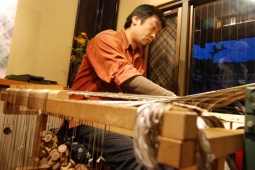Preserving Handcrafts: Traditional Crafts In a Technological Age
People make machines, which then make many of the things we need for modern life. Some people, though, think it important to keep making things by hand, regardless of the machine's speed and efficiency.
What is it that makes a person devote years of practice to making a thing that machines can turn out in vast quantity?
Is the language of art the only venue for a discussion on the "why" of making things by hand, and the only basis for assigning a value to hand-made things, or are there other threads that should be picked up and added to the debate?
At the Kyoto Institute of Technology, practitioners of an ancient craft met to discuss, demonstrate, teach, and learn methods, techniques, and patterns of design. They also shared their knowledge with those who design the machines and engineer the materials that are creating a technologically-based future.
Where, between the ancient and the yet-to-be-made, does the true value lie for those who pursue and practice traditional handcrafts?

